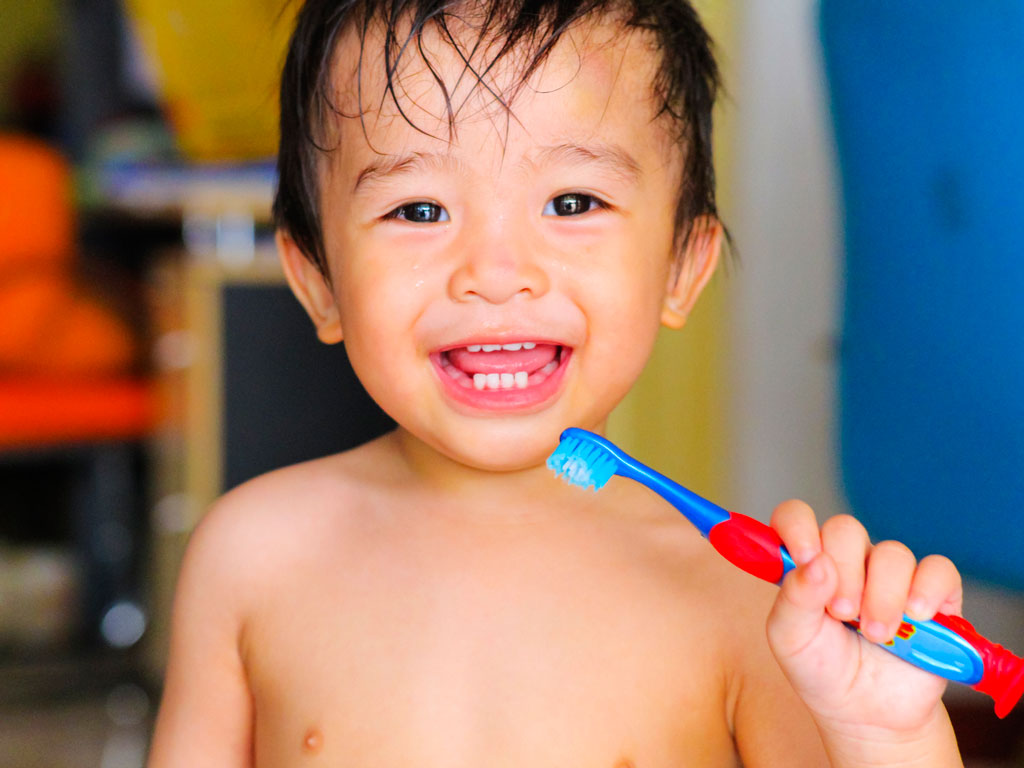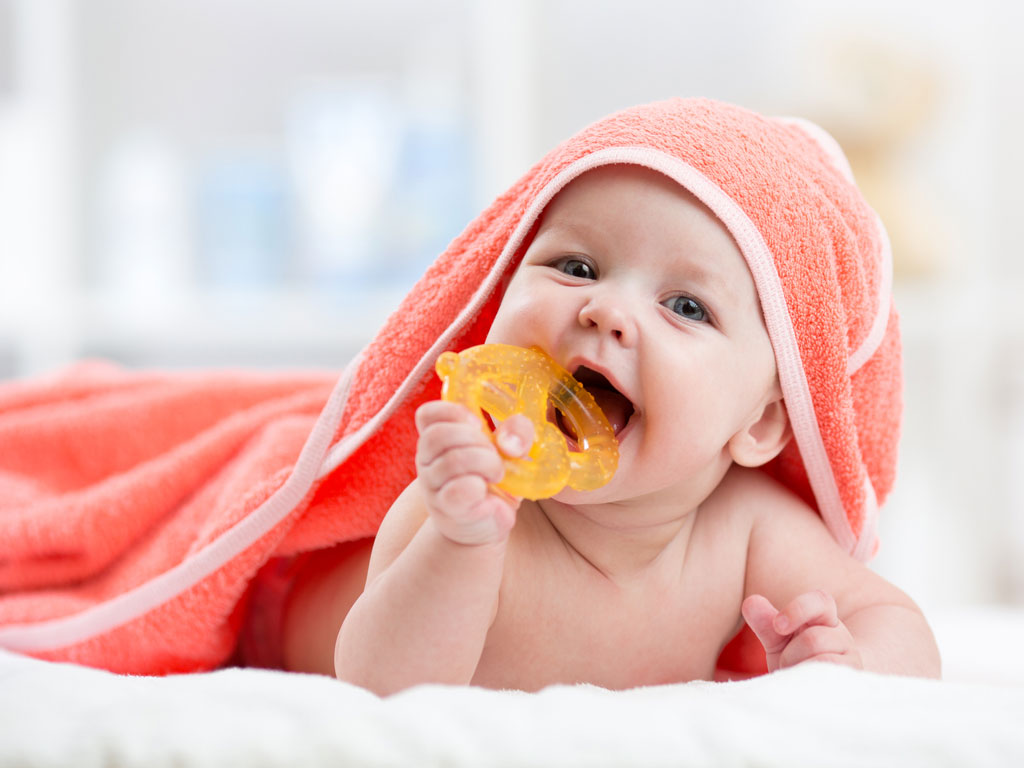by Dr. Vinson Diep and Stephanie Lopes
Is your baby waking up in the middle of the night? Do they have increased drooling along with swollen and tender gums? Do they seem fussier and more irritable than normal? Are they gnawing and chewing on everything? Or, alternatively, do they seem to have a decreased appetite and refuse to eat?
All of these are signs of teething, according to board-certified pediatrician Dr. Vinson Diep, whose office is located at Kapiolani Medical Center for Women & Children.
Dr. Diep frequently assists parents in navigating the signs and symptoms of teething while also advising on ways to comfort children during this sometimes-uncomfortable stage of development. He kindly offers the following teething information to help dispel common teething confusion and to assist parents in soothing their child’s smile.

What do people think are signs of teething – when they are not?
Many tales exist of the signs of teething, which are passed down from generation to generation. But some of these are not, in fact, signs of teething.
“It is true that sometimes teething can cause elevated temperatures, but high fevers are usually not the result of teething,” says Dr. Diep. Instead a fever may indicate that your child is sick.
“Some parents also blame cough, runny nose, vomiting, and even diarrhea on teething, which is also not true,” Dr. Diep continues. Consult your pediatrician for further advice if your child is experiencing any of these non-teething symptoms.
When do teeth grow in?
If your child is approaching anywhere from six months to one year of age, they may be struggling with the pains of teething. Typically a child’s first tooth will grow in when they are six to ten months of age, and all baby teeth may be grown in by the time they reach 23 to 33 months old.
“If there are no signs of teeth by 18 months, parents should discuss with their pediatrician, who will likely recommend a dental referral (if not already being seen by a dentist),” explains Dr. Diep.
How can I help alleviate my child’s teething discomfort?
Is the tooth fairy already preparing to visit your child’s pillow? Then your child might be experiencing teething pains, and there are safe actions parents can take to alleviate their child’s discomfort.
“When babies are teething, cold things usually help make them feel better. Parents can try to wipe the gums with cool washcloths. They can also use teething rings – even putting them in the refrigerator. Popsicles also can help,” says Dr. Diep.
“Other methods include massaging the gums with a clean finger and, if necessary, giving pain medication such as acetaminophen or ibuprofen,” Dr. Diep continues.

What shouldn’t parents do for teething?
Some social media buzzes to help with teething are not always recommended by the American Academy of Pediatrics (AAP), such as teething necklaces or beads and teething gels.
“The teething necklaces or bead strings may break off and are a choking hazard for babies,” explains Dr. Diep.
“The teething gels often contain benzocaine or lidocaine, which are topical anesthetics and are absorbed through the gums. This can lead to a condition called methemoglobinemia which presents as pale, grey, or blue-colored skin and lips, shortness of breath, fatigue, and headache,” Dr. Diep illuminates.
“Homeopathic teething tablets are also not recommended by AAP,” Dr. Diep says.
What should parents do when the first tooth does appear?
Parents can start oral hygiene habits as early as the first tooth appears!
“Start with simply wiping the teeth with a clean washcloth to get baby used to having their teeth cleaned,” Dr. Diep advises.
“After that, parents can start brushing their children’s teeth twice per day using a fluoride-containing toothpaste. For babies and infants, the amount of toothpaste generally recommended on the toothbrush is the size of a grain of rice,” Dr. Diep continues. “Once children reach age three, they can use a pea-sized amount of toothpaste like adults.”
“Some kids want to brush by themselves, and it’s okay to let them at first,” says Dr. Diep. “But parents should typically help at the end to ensure that the teeth are clean. It is most important to clean before bedtime to prevent cavities.”
“Make teeth brushing part of children’s daily routine,” Dr. Diep encourages. “Parents can even brush as a family to show children that brushing is normal.”
When should parents see a doctor about teething?
Second guessing when to bring a child to the doctor can be a frequent internal conflict, especially surrounding something as normal as teething.
However, Dr. Diep advises to bring your child to the doctor if any of the following symptoms occur: high fever (might be a viral infection), vomiting, diarrhea, decreased oral intake, or decreased number of wet diapers.
Also regularly seeing a pediatrician can assist in keeping your child healthy – including their smile. “Dentists and even some pediatrician offices can help with oral hygiene by applying fluoride to prevent cavities,” Dr. Diep explains. “There are also multivitamins with fluoride or fluoride drops that can be prescribed for babies and children to take.”
“Fortunately, most children make it through teething without any serious problems!” Dr. Diep concludes.
For any questions about teething, parents should always ask their pediatrician or dentist. Also, a helpful website created by AAP is www.healthychildren.org. If you would like to speak more with Dr. Diep, call 808-945-9955 or email pediatrics@doctordiep.com
First Dentist Visit
According to the American Academy of Pediatric Dentistry and Hawaii Dental Service, a child should go to the dentist when the first tooth appears, or at age 12 months, whichever comes first.
Parents can expect the following at a child’s first dentist appointment:
- a basic visual examination of the teeth and mouth
- tips and coaching about how parents can care for the child’s teeth at home
- advice to prevent cavities with a healthy diet and lifestyle
For more dental care tips and information, visit HawaiiDentalService.com/DentistbyOne





